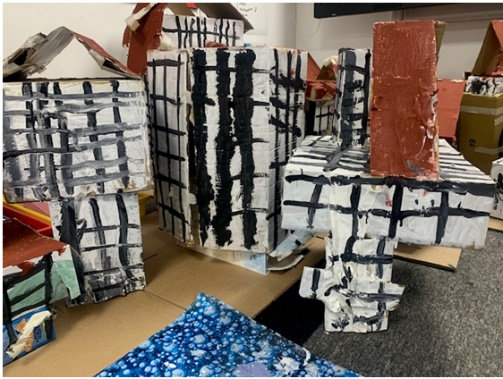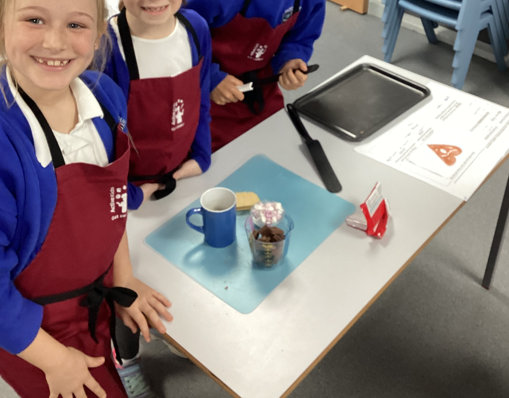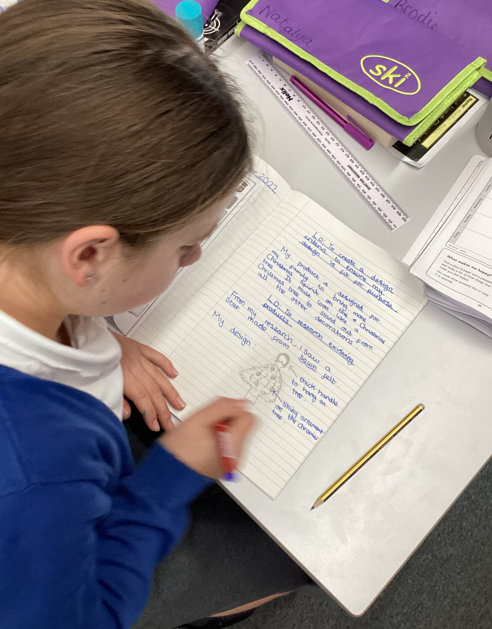Design & technology
Intent
At Saint James Primary School, our intent is to develop a Design Technology curriculum that embodies the Christian school values of love, respect, and courage. We believe that Design Technology empowers students to be creative and innovate through the process of designing new products.
Our curriculum aims to equip students with the necessary technical knowledge and skills to work confidently and safely with tools, equipment, and a variety of materials. By engaging in purposeful and engaging projects that integrate with other subjects, students learn to consider the needs and requirements of the end-users. We encourage students to take ownership of their learning, fostering independence and a sense of pride in their creations.
Central to our curriculum is the "design, make, and evaluate" model, which guides students in developing a deep understanding of design criteria and the determination to refine their products. This is the foundation of how we can build the designers of the future. We foster an environment that promotes emotional resilience, where students embrace challenges as opportunities for growth. They are encouraged to plan, test, and adapt their ideas, knowing that it is through this that their products can be successful.
In addition to nurturing creativity, our curriculum sparks curiosity and encourages research. Students explore the latest technological innovations in materials, systems, and products, raising thought-provoking questions and evaluating existing designs. By engaging in hands-on activities, such as food technology, students develop practical skills preparing them for later life.
At Saint James Primary School, we are committed to nurturing reflective and proactive learners who embody the values of love, respect, and courage. They show courage in the face of challenge by persevering, show love when working as a team and show respect when evaluating and discussing their peers’ designs. We firmly believe that Design Technology is not only relevant to our students' lives but also essential to the culture of our nation. It equips them with real-world skills and prepares them for an ever-changing future.
I embody the spirit of a designer, I...
• Design and create products.
• Make a range of products using technical skills.
• Evaluate my own and my peers’ designs and products.
• Know a range of products.
Implementation
• Design and Technology is integrated into the Early Years environment at Saint James Primary School, offering continuous and enhanced provision. This is done through the children having access to a variety of materials and equipment which give them the opportunity to create with materials, design for a purpose, and experiment with function.
• Each year group participates in 2 or 3 Design and Technology projects throughout the year, each centred around an enquiry question and a given skill focus.
• These projects consist of approximately 6 lessons, blocked across 3 afternoons in Key Stage 1 and 2.
• Our curriculum follows the National Curriculum and focuses on the three main areas of design, make, and evaluate.
• Design and Technology projects are purposeful and linked to the half-term project.
• Students use Design and Technology books from Year 1 to document designs and evaluations.
• Photographic evidence is collected when necessary.
• A progression of skills document outlines the specific design and technology skills taught in each year group, building on prior learning.
• The vocabulary of Design and Technology is explicitly taught.
We aim to foster creativity, critical thinking, and problem-solving skills through our Design and Technology curriculum at Saint James Primary School.
Impact
Identification of Key Skills:
We have a clear progression of skills document that helps us identify key Design and Technology skills. Our teachers assess students' progress both at the point and after the point of teaching against these skills as part of their projects.
Emphasis on Knowledge:
In our Design and Technology curriculum at Saint James Primary School, we place a strong emphasis on knowledge. We assess Design and Technology skills against our Design and Technology progression of skills document during the teaching process but also allow time for the children to discuss what they now know. This assessment is typically demonstrated through the final design or product at the end of each project. Additionally, key knowledge is assessed beyond the teaching period, usually in the following unit or at another suitable point in the year.
Monitoring Curriculum Provision:
To ensure the effective provision of our curriculum, the design and technology subject leader actively monitors its implementation. This monitoring includes various methods such as lesson observations, learning walks, book looks and scrutiny of lesson plans. We also evaluate the outcomes of children's work sampling and conduct pupil conferencing. By reviewing assessment outcomes, our subject leader can evaluate the impact of the design and technology curriculum and strive for the highest possible outcomes for our students.
Curriculum overview
A summary of the Design Technology curriculum can be found in the accordian container below:
!
WarningFor additional information regarding the curriculum please
email our Curriculum Leader
Food
- name and sort foods into the five groups in the Eat Well Guide;
- understand that everyone should eat at least five portions of fruit and vegetables every day and start to explain why;
- use what they know about the Eatwell Guide to design and prepare dishes;
- use their knowledge of existing products and their own experience to help generate their ideas;
- with support, follow a simple plan or recipe;
- explain positives and things to improve for existing products;
- talk about their design ideas and what they are making;
Mechanisms
- design products that have a purpose and are aimed at an intended user;
- explain how their products will look and work through talking and simple annotated drawings;
- begin to select from a range of hand tools and equipment, such as scissors, cut, shape and
score materials with some accuracy;
- evaluate their products and ideas against their simple design criteria;
- explore and create products using mechanisms, such as levers and sliders;
Structures
- build simple structures, exploring how they can be made stronger, stiffer and more stable;
- plan and test ideas using templates and mock-ups;
- select from a range of materials, according to their characteristics;
- learn to use hand tools and kitchen equipment safely and appropriately assemble, join and
combine materials as they work, start to identify strengths and possible changes they might
make to refine their existing design;
Food from different cultures
- use a range of materials and components, including textiles and food ingredients;
- use a range of materials and components, including textiles and food ingredients;
- explain where in the world different foods originate from;
- understand that all food comes from plants or animals;
- understand that food has to be farmed, grown elsewhere (e.g. home) or caught;
Lollipop stick houses
- understand and follow simple design criteria;
- design models using simple computing software;
- explore what materials products are made from;
- start to understand that the iterative process sometimes involves repeating different
stages of the process;
Design and make a vehicle
- begin to use simple finishing techniques to improve the appearance of their product,
such as adding simple decorations;
- explore and evaluate existing products mainly through discussions, comparisons and simple
written evaluations;
- talk about and start to understand the simple working characteristics of materials and
components;
- explore and create products using mechanisms, such as levers, sliders and wheels;
Textiles
- select from a range of materials, textiles and components according to their characteristics,
Practical skills and techniques;
- use a range of materials and components, including textiles and food ingredients;
- demonstrate how to cut, shape and join fabric to make a simple product;
- manipulate fabrics in simple ways to create the desired effect;
- use a basic running stich;
Food
- with support, follow a simple plan or recipe;
- begin to select from a range of hand tools and equipment, such as scissors, graters, zesters, safe knives, juicer;
- use a range of materials and components, including textiles and food ingredients;
- cut, peel and grate ingredients, including measuring and weighing ingredients using measuring cups;
Food
- start to know when, where and how food is grown (such as herbs, tomatoes and strawberries) in the UK, Europe and the wider world;
- understand how to prepare and cook a variety of predominantly savory dishes safely and hygienically;
- with support, use a heat source to cook ingredients showing awareness of the need to control the temperature of the hob and/or oven;
- use a range of techniques such as mashing, , crushing, grating, cutting;
- start to understand seasonality;
- identify the design features of their products that will appeal to intended customers;
- learn to follow hygiene procedures explore what materials/ingredients products are made from and suggest reasons for this;
Textiles - purses
-
use a wider range of materials and components, including construction materials and kits, textiles and mechanical and electrical components;
-
cut, shape and score materials with some degree of accuracy;
-
assemble, join and combine material and components with some degree of accuracy;
-
demonstrate how to measure, cut, shape and join fabric with some accuracy to make a simple product;
-
begin to select and use different and appropriate finishing techniques to improve the appearance of a product such as hemming, tie-dye, fabric paints and digital graphics;
</text>
Structures - Tudor houses
- use their knowledge of a broad range of existing products to help generate their ideas;
- use annotated sketches and cross-sectional drawings to develop and communicate their ideas;
- with growing confidence, carefully select from a range of tools and equipment, explaining their choices;
- cut, shape and score materials with some degree of accuracy;
- assemble, join and combine material and components with some degree of accuracy;
- evaluate their product against their original design criteria;
- apply their understanding of how to strengthen, stiffen and reinforce more complex structures in order to create more useful characteristics of products;
Mechanical systems
-
use computer-aided design to develop and communicate their ideas;
-
design innovative and appealing products that have a clear purpose and are aimed at a specific user;
-
place the main stages of making in a systematic order;
-
use a wider range of materials and components, including mechanical components;
-
consider their design criteria as they make progress and are willing to alter their plans, sometimes considering the views of others if this helps them to improve their product
-
explain how mechanical systems such as levers and linkages create movement;
</text>
Food - digestive system
- explain that a healthy diet is made up of a variety and balance of different food and drink, as represented in the Eatwell Guide and be able to apply these principles when planning and cooking dishes;
- understand that to be active and healthy, nutritious food and drink are needed to provide energy for the body;
- prepare ingredients using appropriate cooking utensils;
- measure and weigh ingredients to the nearest gram and millilitre;
- start to independently follow a recipe;
- use a range of techniques such as mashing, whisking, crushing, grating, cutting, kneading and baking;
- explore what ingredients products are made from and suggest reasons for this;
- when designing, explore different initial ideas before coming up with a final design;
Electrical systems
- explain how particular parts of their products work;
- develop and follow simple design criteria;
- select from a range of materials and components according to their functional properties and aesthetic qualities;
- learn to use a range of tools and equipment safely, appropriately and accurately
- with growing independence, measure and mark out to the nearest cm and millimetre;
- evaluate the key events, including technological developments, and designs of individuals in design and technology that have helped shape the world;
- understand and demonstrate how mechanical and electrical systems have an input and output process;
- make and represent simple electrical circuits, such as a series and parallel, and components to create functional products;
- use a wider range of materials and components electrical components;
Mechanical systems
- use their knowledge of a broad range of existing products to help generate their ideas;
- use annotated sketches to develop and communicate their ideas;
- complete detailed competitor analysis of other products on the market;
- explain how mechanical systems, such as cams, create movement and use mechanical systems in their products;
- select from a range of materials and components according to their functional properties and aesthetic qualities;
- learn to use a range of tools and equipment safely and appropriately;
- use a full range of materials and components, including construction materials and kits, textiles, and mechanical components;
- assemble, join and combine materials and components with accuracy;
Food - Greek
- understand that food is processed into ingredients that can be eaten or used in cooking;
- explain that foods contain different substances, such as protein, that are needed for health and be able to apply these principles when planning and preparing dishes;
- adapt and refine recipes by adding or substituting one or more ingredients to change the appearance, taste, texture and aroma;
- alter methods, cooking times and/or temperatures;
- independently follow a recipe;
Structures - pyramids
- use research to inform and develop detailed design criteria to inform the design of innovative, functional and appealing products that are fit for purpose and aimed at a target market;
- use cross-sectional drawings to develop and communicate their ideas;
- with growing confidence, select from a wide range of tools and equipment, explaining their choices;
- independently take exact measurements and mark out, to within 1 millimetre;
- evaluate their ideas and products against the original design criteria, making changes as needed;
- apply their understanding of how to strengthen, stiffen and reinforce more complex structures in order to create more useful characteristics of products;
Textiles - historical tapestry
- use annotated sketches to develop and communicate ideas;
- demonstrate how to measure, make a seam allowance, tape, pin, cut, shape and join fabric with precision to make a more complex product;
- join textiles using a greater variety of stitches, such as backstitch, whip stitch, blanket stitch;
- refine the finish using techniques to improve the appearance of their product, such as sanding or a more precise scissor cut after roughly cutting out a shape;
- use a full range of materials and components, including textiles;
- critically evaluate the quality of design, manufacture and fitness for purpose of products as they design and make;
Food - Eastern Europe
-
create step-by-step plans as a guide to making;
-
know, explain and give examples of food that is grown (such as pears, wheat and potatoes), reared (such as poultry and cattle) and caught (such as fish) in the UK, Europe and the wider world;
-
understand about seasonality, how this may affect the food availability and plan recipes according to seasonality;
</text>
Mechanical systems and structures - fairground ride
- design products that have a clear purpose and indicate the design features of their products that will appeal to the intended user;
- explain how particular parts of their products work;
- cut a range of materials with precision and accuracy;
- use a full range of materials and components, including construction materials and kits, textiles, and mechanical components;



